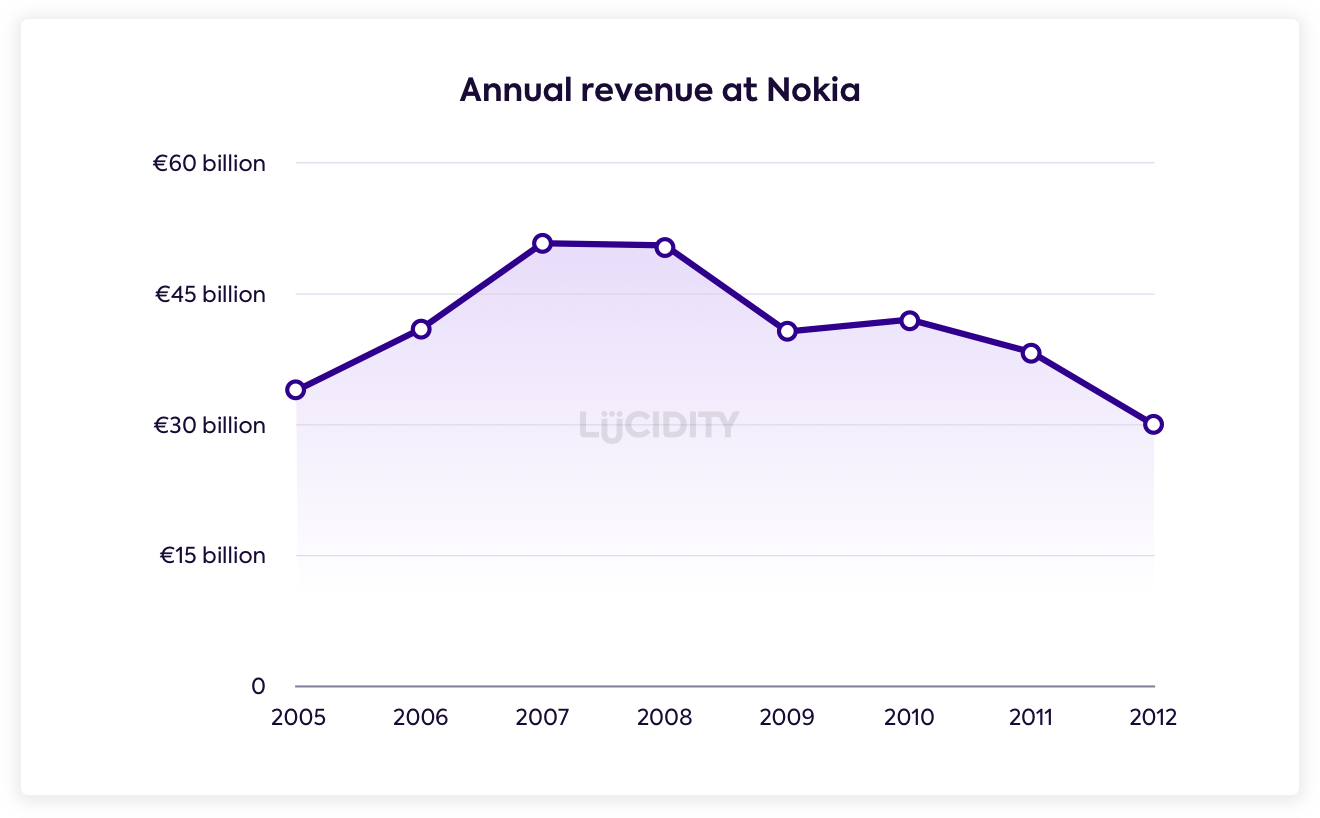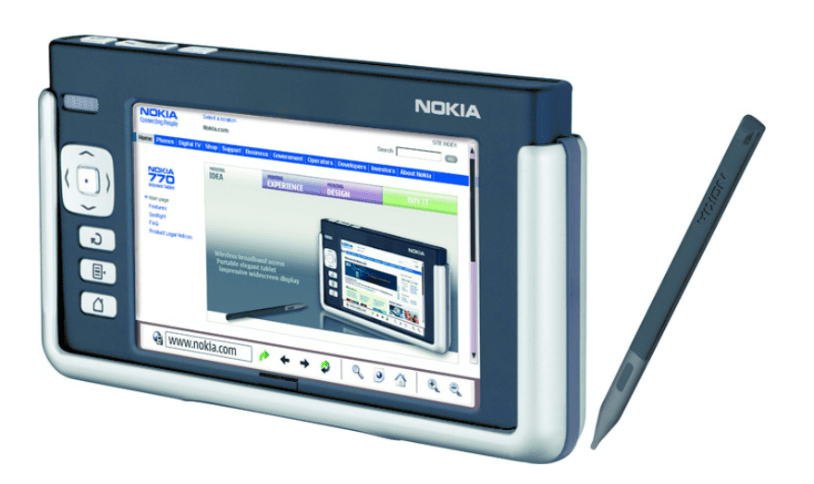Nokia was the leading manufacturer of mobile phone devices from their initial concept through to 2007, when the new generation of smart phones began to appear in the marketplace. Nokia quickly lost it’s place as market leader and went through numerous structural changes to find a place in the market.
In the decade from 2007 Nokia’s marketshare had plummeted. While Samsung was rising to become the quality Android phone and while Apple was continuing to impress with their evolved iPhone series, Nokia was being written off as out of touch and unfashionable. A huge fall for the company that had modelled itself on being the fashionable phone.
Despite attempts at product placements in movies such as Star Trek (2009) and Man of Steel (2013) they could not recover from several large strategic mistakes they had made earlier.
Ironically, prior to this period, Nokia was a company with a history of flexibility and adaptation. They had come to dominate the growing consumer mobile phone market.
Strategic Mistakes:
While many point to the iPhone as the reason behind Nokia’s decline, it really is just the catalyst that took advantage of years of strategic mistakes prior to 2007. These strategic decisions related to hardware, software and commercials.
American CDMA Approach:
The CDMA technology for mobiles was used by two of the largest networks in the US, Nokia supported this on a limited number of handsets which hindered their marketshare. Nokia’s positioning on CDMA was further confused when they announced a joint venture with Sanyo in February 2006, only to dissolve the agreement in July of the same year.
American Phone Design:
Until the launch of Motorola’s Razr flip-phone in 2004 Nokia was largely dominant within the market. This fresh flip-phone design was dismissed by Nokia as a fad and the response was to continue to make the standard shared flat phones. By July 2006 Motorola had sold over 50 million units.
American Sales Approach:
Nokia’s sales strategy was direct to consumer with no relationships with operators, promoting and strengthen their own brandname, as they had done in European and other regional markets. Nokia’s approach was to brand the phones as Nokia, with consumers buying into the Nokia software and approach. However, in the US it was far more common for people to purchase subsidised phones on contracts and the carriers are more powerful in the relationship. Rival phone makers were more accommodating around these carriers and their requests and thus favoured by the carriers in promoting phones to the mass market.
Nokia’s longstanding weakness in the US market allowed competitor products, powered by Apple and Android systems, to take hold from 2007 onwards.
In addition to the US marketplace issues Nokia has a software strategy which prevented it progressing and permitted it to lose marketshare.
Symbian Operating System:
Initially a strength for Nokia was their chosen operating system Symbian, used in partnership with Ericsson and Motorola, and grabbing the majority global marketshare by the mid 2000s. However by 2007/2008 this OS was clunky in comparison to competitors and not supported by many applications. Revisions of Symbian were provided along with the creation of a Symbian Foundation by Nokia in 2008, discussed below, but it was not advanced or supported enough to combat Android and iOS.
Nokia’s follow up OS, MeeGo, was developed in partnership with Intel but largely became another distraction, with a further change of direction in a partnership with Microsoft happening only a few years later. Building a new OS from the ground up when marketshare was already under threat from the mature iOS and Android was a poor choice, further delaying Nokia in getting back on the front foot.
Digital Ecosystem:
The concept of digital ecosystems have been around for many years where software works on a variety of devices. Google, Microsoft and Apple provide digital ecosystems, whereby they offer multiple services such as email, document management, messaging and more all under their single banner. Apple have long been a master of the digital ecosystem with their iDevice ranges plugging into services such as Music and the App Store. Google have had a large push with the gServices, such as mail and play, while Microsoft purchased Hotmail and pushed the Office 365 packages.
A further attempt to unseat Android was The Symbian Foundation. This was a direct attempt to do what Android did in gathering industry players to a single OS, supporting and developing. Symbian had it’s own app store, but with a tiny amount of apps within it.
Nokia launched the Ovi digital ecosystem as a direct response to these threats, however it was dogged with issues. The launch was widely regarded as a failure and coming in 2009, when users were already deeply ingrained into both Android and iOS, was too little, too late.
Arguably if Nokia had taken a partnership with Android, as they were offered, early on then they would have been able to at least secure position against Samsung, albeit at a loss of control and power in the marketplace. Ironically the result would have been similar to Symbian with many competitor phones on the same OS.
Innovation Department:
Nokia’s innovation department was advanced, having prototype touch screen phones and potential tablets years before they revolutionised the marketplace. Their advancements were not limited to just hardware, for software around video conferencing was also present. Internal difficulties prevented some of these projects from being launched, although a testament to their innovation strategy was the Internet Tablet 770 released several years before the iPad and shown below.
Innovation at Nokia was very active in the early years of their smart phone era, with many hundreds of patents and concepts being created annually. In the early 2000s a Venture Fund was founded and an acquisition strategy to collect ideas and talent was formed.
Many of the successes around innovation came from Nokia’s phone design, of which there have been many ground breaking devices. Unfortunately though for Nokia the hardware was not enough and it’s software remained old and unfit for purpose in an advancing smartphone age. Software simply was not the core competence of Nokia.
The competition meanwhile had efficiency advantages, with Samsung producing it’s own chips, displays and other hardware items. Under increasing pressure against these new competitors, powered on the Android system, CEO Kallasvuo (2006-2010) created a climate of increase pressure and fear at work which further stifled innovation when it was most required, when the threat from competition was huge.
Ahh the power of hindsight! It’s easy for any business to make mistakes, but with careful planning and looking at your external environment as well as your internal ecosystem should help you best prepare to not do a Nokia…
Need help getting your strategy right?
Our strategy software has all the tools and guidance you need to make sure you don't make mistakes like these. Book a demo and we'll show you how.













